Articles
- Page Path
- HOME > J Korean Acad Nurs > Volume 39(3); 2009 > Article
-
Original Article
- Construction of the Structural Equation Model on Substance Use in Adolescents
- Jeongyee Bae, Panuncio Rosel
-
Journal of Korean Academy of Nursing 2009;39(3):446-457.
DOI: https://doi.org/10.4040/jkan.2009.39.3.446
Published online: June 29, 2009
1Associate Professor, Department of Nursing, Inje University, Busan, Korea.
2Research Assistant, Department of Nursing, Inje University, Busan, Korea.
- Address reprint requests to: Bae, Jeongyee. Department of Nursing, College of Medicine, Inje University, 633-165 Gaegeum-dong, Busanjin-gu, Busan 614-735, Korea. Tel: 82-51-890-6823, Fax: 82-51-896-9840, jibai@inje.ac.kr
Copyright © 2009 Korean Society of Nursing Science
Abstract
-
Purpose
- The aim of this study was to construct a structural equation model that would further explain the continuously increasing substance use disorder in Korean adolescents.
-
Methods
- Survey visits using a structured questionnaire were conducted with 3,885 students in 2 middle schools and 2 high schools in Busan. A total of 13 instruments were used in this model. The analysis of data was done with both SPSS 14.0 for descriptive statistics and AMOS 5.0 for covariance structure analysis.
-
Results
- Based on the constructed model, belief on substance use was found to have a significantly direct effect in influencing adolescent substance use. In addition, other factors such as family environment, satisfaction with school life, self-concept, social support, and personality vulnerability indirectly affected substance use. The final modified model yielded Chi-square=2,987 (p<.001), df=121, χ2/df=22.1, GFI=.96, AGFI=.93, NFI=.91, PNFI=.72, PGFI=.72, RMSEA=.07 and exhibited fit indices.
-
Conclusion
- This study constructed a model that addresses the factors related to adolescent substance use and explains the relationship of these factors in influencing substance use among Korean adolescents. Findings from this study can contribute to designing appropriate prevention strategies to reduce substance related disorders in adolescents.
This work was supported by the Korea Research Foundation Grant funded by Korean Goverment (KRF-2006-311-E00114).
- 1. Aas H, Klepp KI, Laberg JC, Aaro LE. Predicting adolescents' intentions to drinking alcohol: Outcome expectancies and self-efficacy. Journal of Studies on Alcohol. 1995;56:293–299.PubMed
- 2. Bae JY. Causal relationships between school adjustment of middle school students and related variables. Journal of Korean Academy of Nursing. 2008;38:454–464.ArticlePubMed
- 3. Carmines E, McIver J. Analyzing models with unobserved models: Analysis of covariance structures. 1981;Beverly Hills, CA, Sage.
- 4. Chang SO, Kim EJ, Seomin GA, Lee SJ, Park CS. Comparison of influential variables for smoking temptation between adolescent and adult smokers. Journal of Korean Academy of Nursing. 2006;36:561–570.ArticlePubMedPDF
- 5. Cho WJ, Kwon IS, Kim KS, Seo KM. Relationship between problematic drinking behavior and the personalities of high school students. Journal of Korean Academy of Community Health Nursing. 2004;15:121–132.
- 6. Chung YO, Lee CW. A study of factor structures of the Barratt Impulsiveness Scale in Korean university students. Korean Journal of Clinical Psychology. 1997;16:117–129.
- 7. Derogatis LR, Govi L. The SCL-90: An out-patient psychiatric rating scale preliminary report. Psychopharmacology Bulletin. 1973;9:13–27.
- 8. Frances A. Diagnostic and statistical manual of mental disorders. DSM-IV. 1994;4th ed. Washington DC, American Psychiatric Association.
- 9. Harter S. The perceived competence scale for children. Child Development. 1982;53:87–97.Article
- 10. Im SB, Lee JE, Yang SO. An analysis of nursing research on addiction in Korea. Journal of Korean Academy of Psychiatric and Mental Health Nursing. 2007;16:14–22.ArticlePDF
- 11. Jessor R, Jessor SL. Problem behavior and psychosocial development: A longitudinal study of youth. 1977;New York, NY, Academy Press.
- 12. June KJ, Sohn SY, So AY, Yi GM, Park SH. A study of factors that influence internet addiction, smoking, and drinking in high school students. Journal of Korean Academy of Nursing. 2007;37:872–882.ArticlePDF
- 13. Kang LJ, Kim HS. Risk and protective factors related to cigarette smoking among Korean male high school students. Consumption Culture Research. 2005;8:121–142.
- 14. Kim GJ. The effect of academic achievements and perceived parental attitudes on self-concepts of elementary and secondary school students. 1984;Seoul, Chung Ang University. Unpublished doctoral dissertation.
- 15. Kim HS. Structural model of delinquent behavior influencing by media violence. 1996;Seoul, Ewha Womans University. Unpublished doctoral dissertation.
- 16. Kim HS. The influence of a family dynamic environment, personality, and smoking on delinquent behavior among Korean adolescents. Journal of Korean Academy of Nursing. 2001;31:641–655.ArticlePDF
- 17. Kim HS, Min BK, Kim HS. Correlation between delinquent and their character pattern and family dynamics. Ulsan University Medical Journal. 1992;1:188–205.
- 18. Kim KI, Kim JH, Won HT. Korean manual of symptom checklist-90-revision. 1984;Seoul, Chungang Aptitude Publishing Company.
- 19. Kim KS. Structural equation model: AMOS 7.0. 2007;Seoul, Hannarae.
- 20. Kim MS, Kwon JH. A test of cognition-mediated model of adolescent smoking behavior. The Korean Journal of Clinical Psychology. 2004;23:297–312.
- 21. Kim YS, Kim JW, Kim SC. A national survey on adolescent alcohol use prevalence and related factors. Korean Journal of Social Welfare. 2001;47(11):71–106.
- 22. Prevalence of drug abuse among adolescents. Korean Association Against Drug Abuse. 2006;Retrieved August 20, 2006. http://www.drugfree.or.kr/drug_bbs/board.php?board=seoul&config=&command=body&no=57&search=&shwhere=subject.
- 23. Kwak KJ. Life satisfaction of adolescents in terms of KLSSA. The Korean Journal of Psychology. 1995;2:5–16.
- 24. Lee KY. A study on the screening scale for potential drug use adolescents (SPDA) and survey of the drinking, smoking, and drug using. 2003;Busan, Korean Association Against Drug Abuse Busan Council.
- 25. Lee SM. Covariance structure analysis. 1990;Seoul, Seongwonsa.
- 26. Min BK, Choi SJ, Lee KH. Korean adolescents' behavioral pattern. 1978;Seoul, Youngsin Academy.
- 27. Park NS, Oh KJ. Effects of methylphenidate treatment on cognitive behavioral symptoms and social, academic & emotional adjustment of ADHD children. The Korean Journal of Clinical Psychology. 1992;11:235–248.
- 28. Park YH. A study about self-esteem, anxiety and depression of smoking adolescent. 2001;Seoul, Chungnam National University. Unpublished doctoral dissertation.
- 29. Phee SS, Oh SW, Park MC. Influences on perceived stress, dysfunctional attitude, self-efficacy, social support, and coping style on maladaptation in the adolescents with substance abuse. Journal of Korean Neuropsychiatric Association. 2000;39:297–308.
- 30. Shin SR, Lee DS, Park JW. The effect of life smoking cessation program-multidisciplinary approach. Journal of Korean Academy of Nursing. 2000;30:110–121.ArticlePDF
- 31. Sin HS, Kim MK. Relationship of psychological types and behavioral characteristics in juvenile delinquents on probation. The Korean Journal of Psychology. 1998;10:227–250.
- 32. Vaux A, Phillips J, Holly L, Thomson B, Williams D, Stewart D. The social support appraisal (SS-A) scale: Studies of reliability and validity. American Journal of Community Psychology. 1986;14:195–219.
- 33. Velicer WF, DiClemente CC, Rossi JS, Prochaska JO. Relapse situations and self-efficacy: An integrative model. Addictive Behaviors. 1990;15:271–283.ArticlePubMed
- 34. Wu NS, Lu Y, Sterling S, Weisner C. Family environment factors and substance use severity in an HMO adolescent treatment population. Clinical Pedriatrics. 2004;43:323–333.
REFERENCES
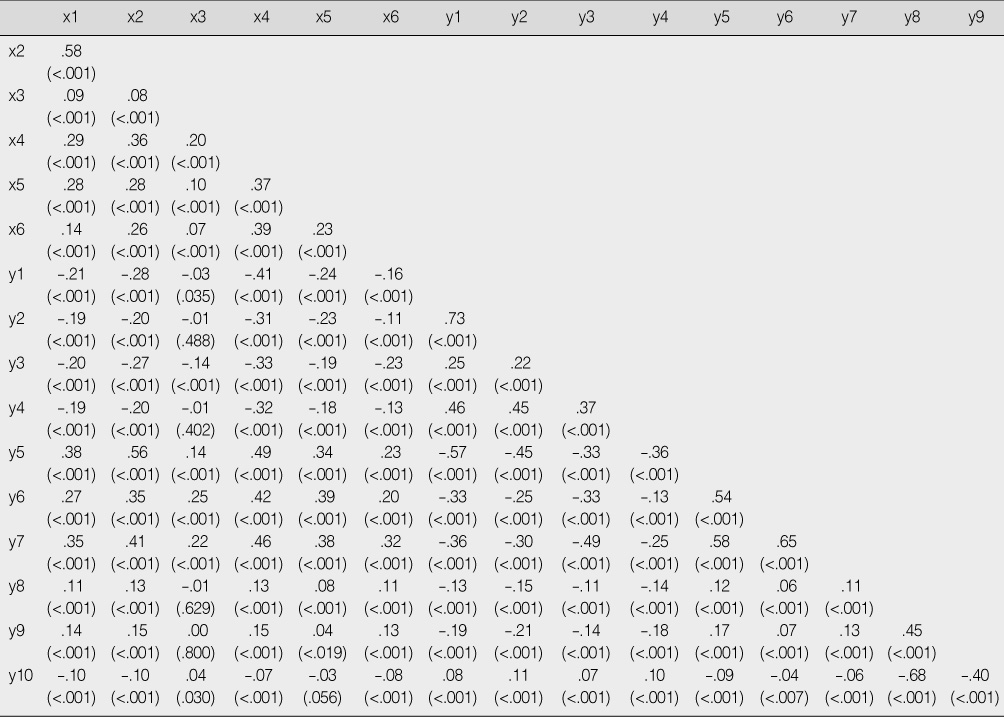
x1=parenting; x2=family satisfaction; x3=school achievement; x4=school adjustment; x5=friend's support; x6=teacher's support; y1=depression; y2=anxiety; y3=impulsiveness; y4=antisocial personality; y5=self acceptance; y6=self esteem; y7=self confidence; y8=perception; y9=self efficacy; y10=substance use.
Figure & Data
REFERENCES
Citations

- Public discourse on substance use behavior as a driver of public policy: a scoping review of South Korean academic and official literature
Meekang Sung, Jihye Han, Carrie G. Wade, Vaughan W. Rees
Addiction Research & Theory.2025; 33(4): 312. CrossRef - Comparison of Risk Factors for Habitual Substance Use Among Adolescents in Korea by Maternal Nationality: Analysis of 18th and 19th Korea Youth Risk Behavior Surveys (2022 and 2023)
Hyeon Ok Ju, So Yeon Park
Children.2025; 12(4): 458. CrossRef - Predictive factors of substance misuse and abuse in South Korean adolescents: a secondary data analysis of the 2021 Youth Risk Behavior Web-based Survey
So Yeon Park
Child Health Nursing Research.2024; 30(1): 67. CrossRef - A Structural Equation Model on Korean Adolescents' Excessive Use of Smartphones
HaNa Lee, JooHyun Kim
Asian Nursing Research.2018; 12(2): 91. CrossRef

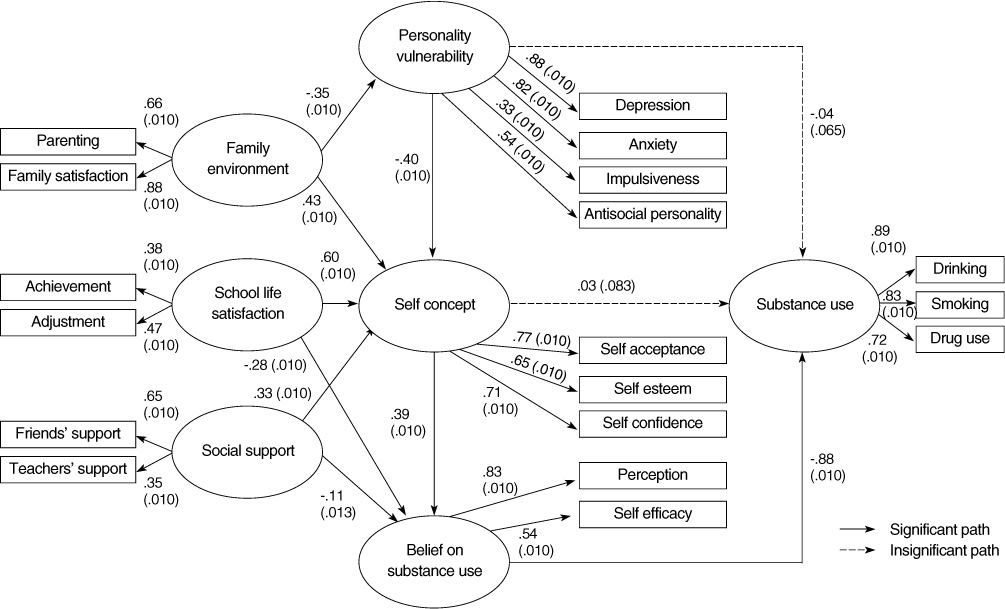
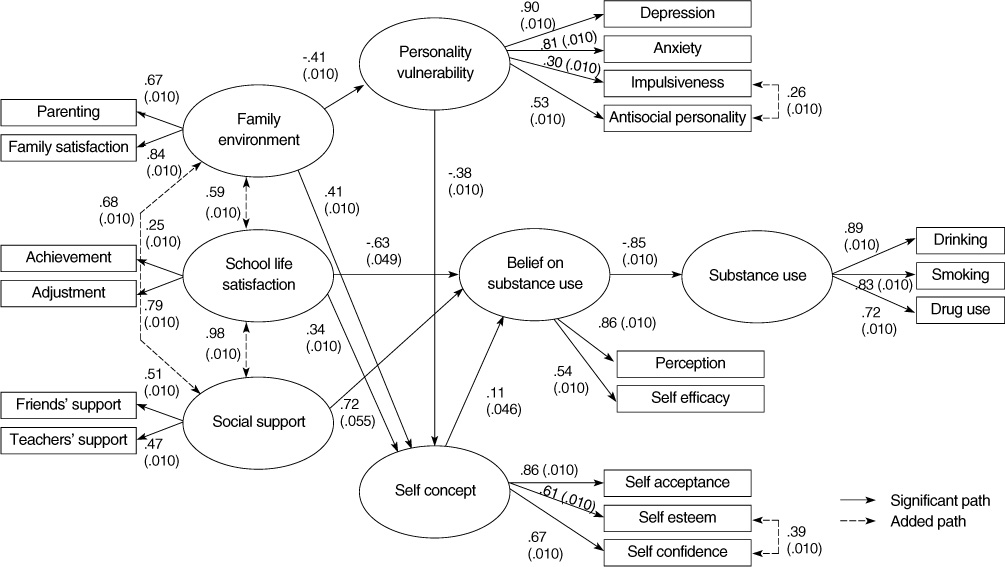
Figure 1
Figure 2
Figure 3
Correlation among Factors (N=3,885)
x1=parenting; x2=family satisfaction; x3=school achievement; x4=school adjustment; x5=friend's support; x6=teacher's support; y1=depression; y2=anxiety; y3=impulsiveness; y4=antisocial personality; y5=self acceptance; y6=self esteem; y7=self confidence; y8=perception; y9=self efficacy; y10=substance use.
Model Fitness Index for Hypothetical and Modified Model (N=3,885)
Direct Effect, Indirect Effect, and Total Effect in Modified Path Model
CR=critical ratio; SMC=squared multiple correlations.
x1=parenting; x2=family satisfaction; x3=school achievement; x4=school adjustment; x5=friend's support; x6=teacher's support; y1=depression; y2=anxiety; y3=impulsiveness; y4=antisocial personality; y5=self acceptance; y6=self esteem; y7=self confidence; y8=perception; y9=self efficacy; y10=substance use.
CR=critical ratio; SMC=squared multiple correlations.
 KSNS
KSNS
 E-SUBMISSION
E-SUBMISSION
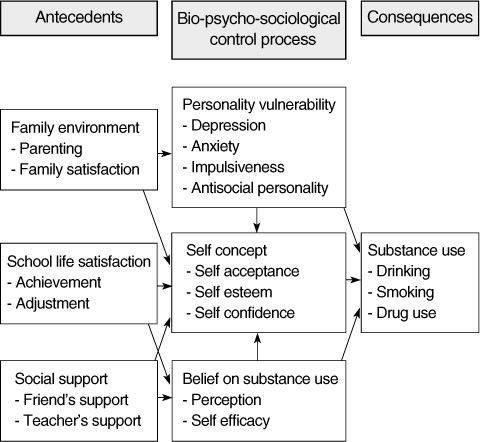


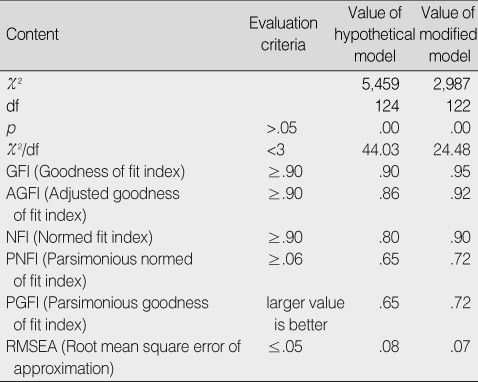
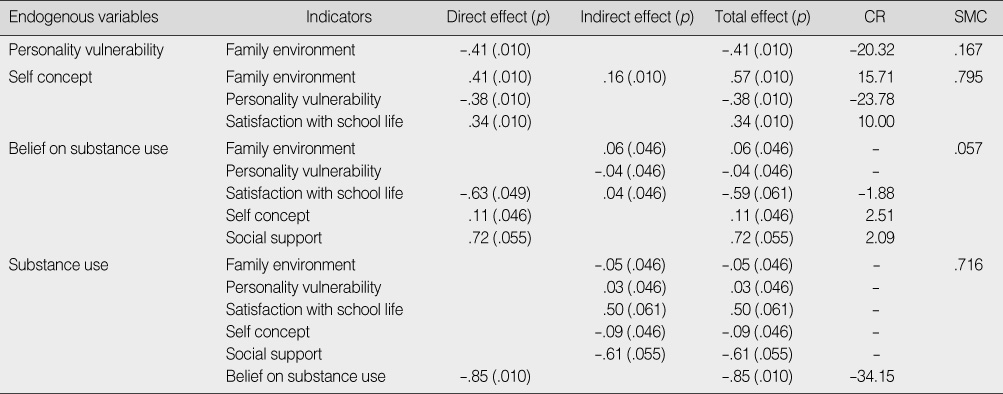
 Cite
Cite

